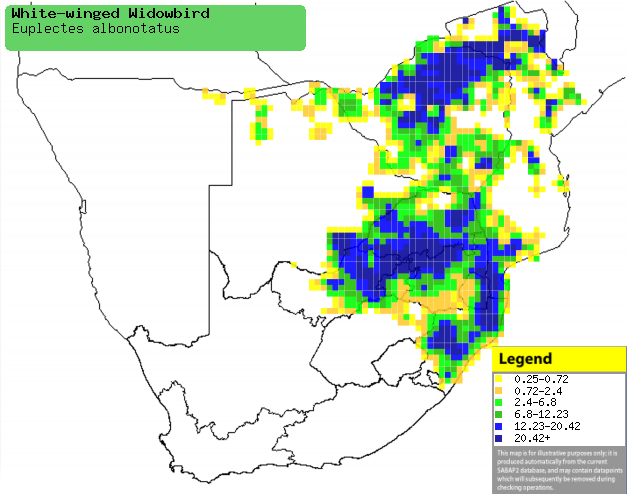|
Euplectes albonotatus
(White-winged widowbird, White-winged widow)
Witvlerkflap [Afrikaans];
iNtakansinsi [Zulu]; Enzunge (applied to some of the bishops, widows and
sparrows) [Kwangali]; Spiegelwidavink [Dutch]; Euplecte à épaules
blanches [French]; Spiegelwida [German]; Viúva-d'asa-branca [Portuguese]
Life
> Eukaryotes >
Opisthokonta
> Metazoa (animals) >
Bilateria >
Deuterostomia > Chordata >
Craniata > Vertebrata (vertebrates) > Gnathostomata (jawed
vertebrates) > Teleostomi (teleost fish) > Osteichthyes (bony fish) > Class:
Sarcopterygii (lobe-finned
fish) > Stegocephalia (terrestrial
vertebrates) > Tetrapoda
(four-legged vertebrates) > Reptiliomorpha > Amniota >
Reptilia (reptiles) >
Romeriida > Diapsida > Archosauromorpha > Archosauria >
Dinosauria
(dinosaurs) > Saurischia > Theropoda (bipedal predatory dinosaurs) >
Coelurosauria > Maniraptora > Aves
(birds) > Order: Passeriformes
> Family: Ploceidae > Genus: Euplectes
Distribution and habitat
Although it has localised populations in Sudan, Ethiopia
and Angola, it mainly occurs from Tanzania, Zambia and Malawi to southern
Africa. Here it is fairly common in Zimbabwe, Mozambique and north-eastern South
Africa, extending into the Caprivi Strip (Namibia) and Botswana. It generally
prefers habitats with rank vegetation and water, such as moist grassland and
marshes, but also in disturbed areas and cultivated land.
|
 |
|
Distribution of White-winged widowbird in southern Africa,
based on statistical smoothing of the records from first SA Bird Atlas
Project (©
Animal Demography unit, University of
Cape Town; smoothing by Birgit Erni and Francesca Little). Colours range
from dark blue (most common) through to yellow (least common).
See here for the latest distribution
from the SABAP2. |
Predators and parasites
It in various forms has been recorded as prey
of the following animals:
- Adults
- Newly-hatched chicks and eggs
- Praomys natalensis (Multimammate mouse)
Brood parasites
It has been recorded as host of the
Diderick
cuckoo.
Food
It mainly eats the seeds of grasses, supplemented with
nectar and insects. The following food items have been recorded
in its diet:
- Plants
- grass seeds
- Bracharia brizantha (Common signal grass)
- Chloris virgata (Feathered chloris)
- Melinis repens (Natal reftop)
- Rottboellia cochinchinensis (Guinefowl grass)
- Setaria sphacelata (Twisted-leaf bristle grass)
- Uruchloa mossambicensis (Bushveld signal grass)
- Hyparrhenia
- Pennisetum
- nectar of Aloe marlothii (Mountain aloe)
- Insects
Breeding
- Polygynous, territorial solitary nester, as one male may mate with up to 4
females in a breeding season, defending his territory against other males as
well as other widowbird and bishop species.
- The nest is built solely by the male, consisting of an oval-shaped
structure with a large side-top entrance, built of dry grass and lined by
the female with finer grass. It is typically placed about 0.3-1.3 metres
above ground in dense grass, which is incorporated into the roof of the
nest.
- Egg-laying season is from October-May, peaking from December-March.
- It lays 2-4 eggs, which are incubated solely by the female for about
12-14 days.
- The chicks are only fed by the female, leaving the nest after about
11-14 days and becoming independent about 22-25 days later.
Threats
Not threatened.
References
-
Hockey PAR, Dean WRJ and Ryan PG 2005. Roberts
- Birds of southern Africa, VIIth ed. The Trustees of the John Voelcker
Bird Book Fund, Cape Town.
|
